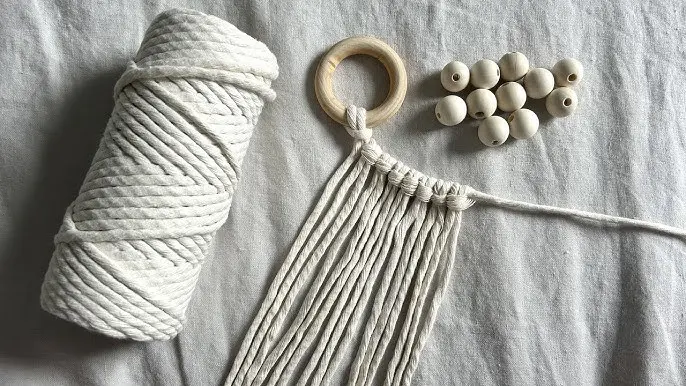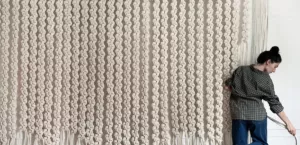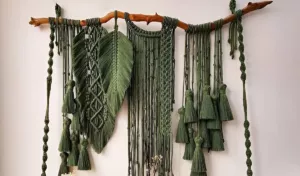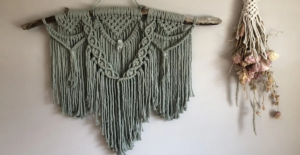Macrame Plant Hanger Yardage Guide: How Much Cord Do You Really Need?
Did you know that nearly 65% of macrame beginners say that “running out of cord” is their biggest frustration? There is nothing worse than being halfway through a beautiful project and realizing you don’t have enough rope. This guide is here to eliminate all that guesswork. You will learn a simple method to always know exactly how much cord you need. Get ready to create beautiful plant hangers with confidence and say goodbye to wasted supplies.
Why Yardage Matters in Macrame
Getting the right amount of cord is the first step to a successful project. When you know your macrame rope length from the start, you can relax and enjoy the process of creating.
The Problem: Wasted Cord and Frustrated Crafters
If you guess how much cord for plant hanger projects you need, one of two things usually happens. You might buy way too much cord, which wastes your money. Or, you might buy too little, which ruins your project and your mood. This problem stops many crafters from even starting. It can make a fun hobby feel stressful.
The Solution: A Simple, Reliable Calculation Method
This guide will give you a clear, formula-based approach. We have done the hard work for you. After reading this, you will have a simple math formula that works every single time. You will never have to guess your macrame yardage again.
Our Method for Finding the Perfect Macrame Rope Length
How did we figure this out? We created many different plant hanger designs. For each one, we carefully measured the exact amount of cord used. We tested simple patterns and complex ones. We looked at what worked and what didn’t. From all this data, we developed a reliable and easy-to-use formula.
Key Takeaway: The most accurate way to determine your macrame rope length is to use a simple multiplication formula based on your desired finished length.
The Core Variables: What Affects Your Cord for Plant Hanger Projects
Four main things change how much cord you will need. Thinking about these before you start will help you make a better calculation.
Variable 1: Desired Finished Length
This is the most important factor. How long do you want your finished plant hanger to be? You need to measure from the very top (where the loop connects to your hook) all the way down to the bottom of the plant pot. A good rule is to measure your pot’s height and then add the amount of empty space you want above it.
Variable 2: Knot Density and Pattern Complexity
The types of knots you use make a huge difference.
- Simple knots like square knots use less cord. They are compact and efficient.
- Complex knots like double half hitches or intricate berry knots use a lot more cord. They wrap around more often and eat up your rope faster.
Variable 3: The Thickness of Your Macrame Cord
The thickness, or diameter, of your cord matters.
- Thicker cord (5mm-6mm): This cord is chunky and beautiful, but each knot you tie with it uses more length.
- Thinner cord (3mm-4mm): This cord is more efficient for knots, but you might need more strands of it to make sure your hanger is strong enough to hold a heavy pot.
Variable 4: Pot Size and Weight
A small, light pot might only need a simple 4-strand hanger. A large, heavy ceramic pot will need a longer hanger and probably more strands (like 6 or 8) to support the weight safely. More strands, of course, mean more total cord.
The Golden Formula: How to Calculate Macrame Yardage
Here it is: the simple formula that will solve all your plant hanger measurements problems.
The Basic Multiplication Rule
The core formula is:
Total Cord Needed = (Desired Finished Length x Multiplication Factor) x Number of Strands
Let’s break that down:
- Desired Finished Length: How long you want the hanger to be (in inches).
- Multiplication Factor: The “magic number” that accounts for the cord used up inside the knots.
- Number of Strands: How many pieces of cord you are using to create the hanger body.
Understanding the Multiplication Factor
This number is the secret to the whole process. It tells you how many times longer your cords need to be compared to the final length of the hanger. For almost all plant hangers, the multiplication factor will be between 4 and 6.
- Use a factor of 4 for simple patterns with basic knots.
- Use a factor of 5 for medium-difficulty patterns.
- Use a factor of 6 for very complex, knot-heavy designs.
Practical Application: Yardage for 5 Popular Plant Hanger Styles
Let’s see this formula in action with some common designs.
Style 1: The Simple Single-Pot Hanger
- Description: This is the classic, beginner-friendly design. It uses 4 strands and a series of square knots.
- Multiplication Factor: 4
- Example Calculation: Let’s say you want a 24-inch long hanger.
- (24 inches x 4) = 96 inches per strand.
- You have 4 strands: 96 x 4 = 384 total inches.
- There are 36 inches in a yard: 384 / 36 = 10.7 yards total.
- You would need about 11 yards of cord.
Style 2: The Intricate Boho Hanger
- Description: This design has more detail. It might use alternating square knots, diagonal knots, and a woven wrap. It often uses 6 strands for a fuller look.
- Multiplication Factor: 5
- Example Calculation: For a longer, 30-inch hanger with 6 strands.
- (30 inches x 5) = 150 inches per strand.
- 150 x 6 strands = 900 total inches.
- 900 / 36 = 25 yards total.
Style 3: The Multi-Tiered (Spider Plant) Hanger
- Description: This hanger holds two or three pots at different levels. It looks complicated, but the calculation is straightforward.
- Approach: You calculate the cord needed for the top section and then add the cord needed for the bottom section.
- Top Tier: For a 20-inch section with 4 strands and a factor of 4: (20 x 4) x 4 = 320 inches.
- Bottom Tier: For another 20-inch section using the same cords (they continue down): (20 x 4) x 4 = 320 inches.
- Total: 320 + 320 = 640 inches.
- Add a 10% safety buffer: 640 x 1.10 = 704 inches.
- 704 / 36 = ~19.5 yards total.
Style 4: The Modern Geometric Hanger
- Description: This style uses many diagonal double half-hitch knots to create sharp angles and patterns. These knots use a lot of cord.
- Multiplication Factor: 6 (this is the highest factor).
- Example Calculation: For a 24-inch hanger with 4 strands.
- (24 inches x 6) = 144 inches per strand.
- 144 x 4 strands = 576 total inches.
- 576 / 36 = 16 yards total. Notice how this uses more cord than the Simple Hanger of the same length.
Style 5: The Quick and Easy Ladder Hanger
- Description: This is the most efficient design. It has very few knots. The cords mostly hang vertically with small rungs holding the pot.
- Multiplication Factor: 3.5 (this is the lowest factor).
- Example Calculation: For a 24-inch hanger with 4 strands.
- (24 inches x 3.5) = 84 inches per strand.
- 84 x 4 strands = 336 total inches.
- 336 / 36 = ~9.3 yards total.
Your Essential Macrame Supplies List
Before you start your project, make sure you have everything you need. Here is your basic macrame supplies list:
- Macrame Cord: This is your main material. Cotton rope is soft and easy to work with. Jute gives a rustic look. Synthetic cords are strong and often cheaper.
- Scissors: A sharp pair of fabric scissors is a must for clean cuts.
- Tape Measure: You cannot do this without one! Accurate measuring is key.
- Mounting Ring or Dowel: This is what you will attach the top of your hanger to.
- Pins & Board (optional but helpful): A corkboard and T-pins let you pin your work down, which keeps it steady while you tie knots.
- Lighter or Fray Check: Used to lightly melt the ends of synthetic cord to stop them from fraying. (Be careful with natural fibers like cotton, as they can burn).

Macrame Wall Hanging Tapestry with Wooden Stick
Elevate your space with this exquisite hand-woven macrame wall hanging that combines natural wooden elements with intricate textile artistry. Featuring elegant tassels and a sturdy wooden mounting stick, this versatile piece serves as stunning wall art, wedding backdrop, or bohemian room accent that brings warmth and texture to any setting.
Step-by-Step: A DIY Macrame Tutorial for a Basic Hanger
Let’s put it all together and make a simple 4-strand plant hanger.
Step 1: Measuring and Cutting Your Cord
You want a 24-inch Simple Single-Pot Hanger. From our calculation earlier, you know you need about 11 yards total. You will cut 4 strands, each 96 inches long (which is 8 feet). Use your tape measure and scissors to cut them precisely. Pro tip: If you are using a cord that twists, gently stretch each strand before you cut to straighten it out.
Step 2: Creating the Hanging Loop
Fold all 4 strands in half so you have 8 working ends. Push the folded loop up through the center of your mounting ring. Then, pull the loose ends down through the loop and pull tight. This is called a Lark’s Head Knot, and it attaches all your cords to the ring.
Step 3: Tying the Main Knots
You will now tie a series of square knots. Separate your 8 strands into 4 groups of 2. To tie a square knot, take the left cord and lay it over the two middle cords, making a number “4”. Take the right cord and lay it over the left cord, then tuck it under the two middle cords and up through the “4” shape. Pull tight. Do this for all 4 groups. Then, move down a few inches and tie another row of square knots.
Step 4: The Gathering Knot and Finishing
Once your knotted section is as long as you want, gather all 8 strands together below the last row of knots. Take a separate, short piece of cord (about 20 inches) and use it to tie a tight wrapping knot around the bundle. Tuck the ends of the short cord back into the wrap to hide them. Trim the ends of the 8 long strands to your desired length, and your hanger is ready for a pot!
Pro Tips for Perfect Plant Hanger Measurements
Here is some expert advice to make sure your project goes smoothly.
Always Add a Safety Buffer
Especially if you are a beginner, always add 10-15% to your final calculated length. If the math says you need 20 yards, cut 22 yards. It is much better to have a little extra than to come up short. You can always trim the excess at the end.
How to Join New Cord Seamlessly
If you do run short, don’t panic. You can add a new cord. The best way is to tie a new knot where one of the cords is running out. Hide the old short end and the new long end inside the knot. Once the knot is tight, you can trim the excess, and it will be almost invisible.
Measuring Twice, Cutting Once
This is the golden rule of all crafting, from woodworking to macrame. Double-check your math and your measurements before you make that first cut. It will save you from a lot of potential headaches.
Frequently Asked Questions (FAQ)
What is the most common mistake when calculating macrame rope length?
The most common mistake is forgetting the multiplication factor. People often just multiply the desired length by the number of strands. This does not account for all the cord that gets used up inside the knots, and you will end up with a hanger that is way too short.
How much macrame cord do I need for a large plant hanger?
For a large hanger (around 36 inches) that holds a big pot, you will likely use 6 strands and a multiplication factor of 5. The calculation would be: (36 x 5) x 6 = 1080 inches. 1080 / 36 = 30 yards. With a safety buffer, you should get about 33 yards.
Can I use different types of cord in one project?
You can, but it is not recommended for beginners. Different cords have different thicknesses and textures. They can stretch differently and make your knots look uneven. It is best to stick with one type and size of cord per project.
What if my pattern doesn’t look like any of the examples?
Look at the knots in your pattern. If they look simple and loose, use a factor of 4. If they look very tight, dense, and diagonal, use a factor of 5 or 6. When in doubt, always use the higher factor and add a safety buffer.
Figuring out how much macrame cord you need does not have to be a mystery. By using the simple formula—(Desired Length x Multiplication Factor) x Number of Strands—you can start every project with confidence. You now have the knowledge to plan for different styles, from the simplest ladder design to the most intricate boho creation. So grab your tape measure, pick out your favorite cord, and get knotting! Your beautiful, perfectly measured plant hangers are waiting to be made.









